Climate Positive Roadmap
Ref’s
Climate Positive
Roadmap

The fashion industry is responsible for up to 10% of global carbon emissions and is on track to double that by 2050. It all sounds scary, but it actually means we have tons of potential to do better for people and the planet if we work together.
It’ll take serious work, and it’ll take all of us, but we’ll do our part to reduce our carbon footprint ASAP. That’s why we made a commitment to be Climate Positive by 2025 and we’re sharing our roadmap with anyone who wants to do the same. Because we can’t do this alone.
In order to become Climate Positive, we needed to know where we’re at today. So we started by measuring our current greenhouse gas footprint.
It’s a big number, but it’s not impossible to get to a place that meets our reduction targets and keeps our business growing sustainably.
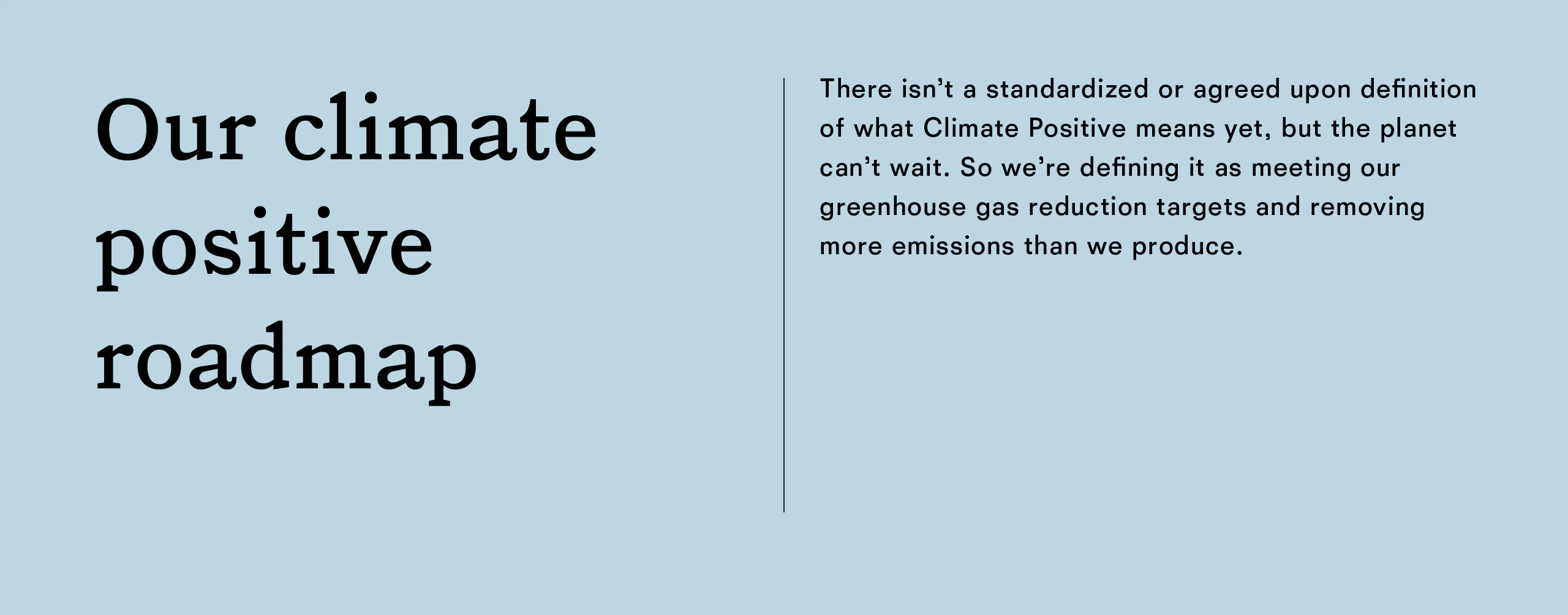
Our climate positive roadmap
There isn’t a standardized or agreed upon definition of what Climate Positive means yet, but the planet can’t wait. So we’re defining it as meeting our greenhouse gas reduction targets and removing more emissions than we produce.
There are a lot of terms out there: climate or carbon neutral, net zero, carbon negative/positive.
Here’s a chart to help you out:

We looked at where most of our emissions came from and identified steps to reduce our footprint in our focus areas: better materials, circularity, transportation, and energy management.

Based on our planned reduction efforts, our work is aligned to global efforts to keep temperature rise below 1.5C (aka science-based). We also overestimated our emissions a bit so far, so we feel really confident that we can meet or beat our commitment if we stick to the work outlined here.
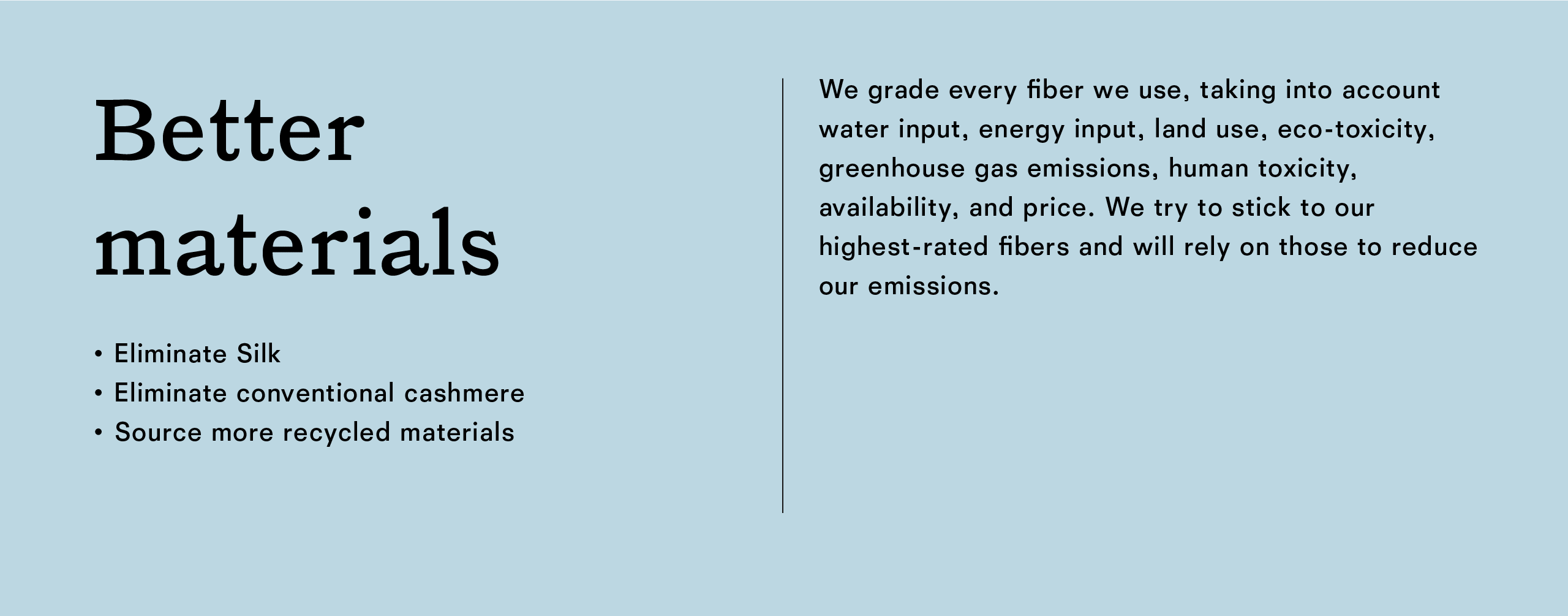
Better materials
• Eliminate Silk
• Eliminate Conventional Cashmere
• Source more recycled materials
We grade every fiber we use, taking into account water input, energy input, land use, eco-toxicity, greenhouse gas emissions, human toxicity, availability, and price. We try to stick to our highest-rated fibers and will rely on those to reduce our emissions.
Our cashmere, leather, and viscose have big carbon footprints. Even though cashmere represents less than 1% of the material we purchase, it accounts for almost half of our footprint due to its high carbon intensity.¹ Pretty expensive sweater.

We’re always working to use more innovative, sustainable fibers. What we’re really excited about isn’t 100% commercially available yet, or may have quality and other tradeoffs. So we’ll have to take a longer-term view. But there are some things we can do right away, like eliminating silk and conventional cashmere in the next year to shrink our sourcing footprint.
¹This is based on our RefScale tool which primarily uses HIGG MSI emission factors for materials. The emission factor for cashmere is much higher than other fibers and further research into this could be helpful for the industry.
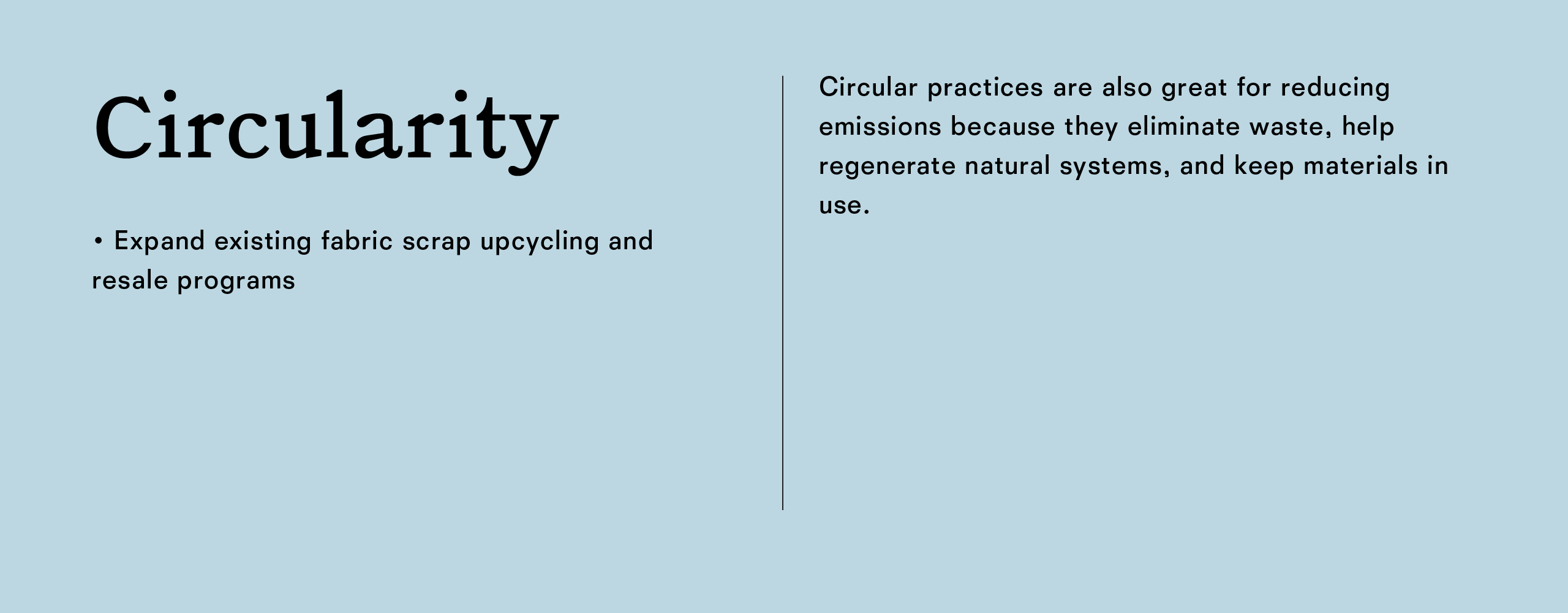
Circularity
• Expand existing fabric scrap upcycling and resale programs
Circular practices are also great for reducing emissions because they eliminate waste, help regenerate natural systems, and keep materials in use.
Circular practices contribute to lower demand for materials, and thus lower CO2e. We found that if we expanded our existing fabric scrap upcycling and resale programs, we could see ~11-23% total reduction potential in our materials footprint. Trash to treasure.

Transportation
• Shift majority of transportation to cargo ship
It takes a lot of fuel to transport our raw materials to our factories and even more to ship our finished goods to our warehouse, retailers, and customers. We use air shipping a lot to get stuff to you on time. But shipping via air is 30x more carbon-intensive than shipping via cargo ship.
So, in order to hit our target, we’ll need to ship as much of our stuff via ocean or ground transport as possible. We’re aiming for about 30% air transit. It’s a challenge that will take a lot of cross-functional effort to achieve, but at least we’ll avoid LAX.


Energy management
• Conduct energy audits for in-house factory and retail operations
• Reduce product mix requiring professional cleaning services
• Educate customers on best garment care practices
A lot of our energy use happens in our supply chain at our mills, dye houses, and yarn producers, but we also need to become more efficient in our own facilities to have the most impact. We’ll start by conducting energy audits to better understand how and when we’re using our energy. Then we’ll work on reducing natural gas consumption throughout all parts of our business.
Up to 2/3 of the impact of a garment happens once you take it home, due to energy-intensive garment care. Our shift to better materials will reduce the need for professional cleaning services and allow for earth-friendly practices like hand-washing and air drying. We know that sounds like a lot of work, so to make its easier on you, we’ll focus on education and engagement to create reductions.

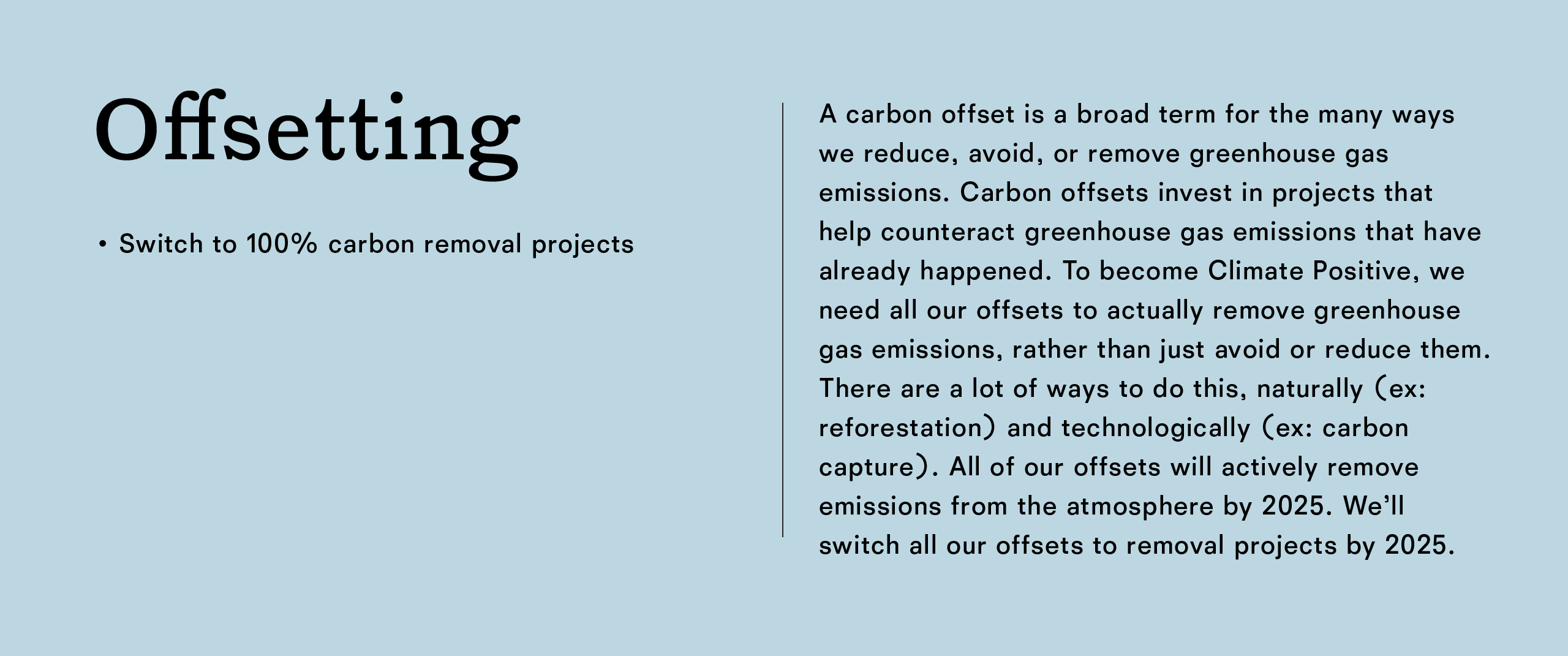
Offsetting
• Switch to 100% carbon removal projects
A carbon offset is a broad term for the many ways we reduce, avoid, or remove greenhouse gas emissions. Carbon offsets invest in projects that help counteract greenhouse gas emissions that have already happened. To become Climate Positive, we need all our offsets to actually remove greenhouse gas emissions, rather than just avoid or reduce them. There are a lot of ways to do this, naturally (ex: reforestation) and technologically (ex: carbon capture). All of our offsets will actively remove emissions from the atmosphere by 2025. We’ll switch all our offsets to removal projects by 2025.
Natural

Afforestation/ Reforestation (AR)
Tree growth takes up CO2 from the atmosphere

Other land-use/ wetlands
Restoration and construction of high carbon, density, anaerobic ecosystems
←
Less costly
Closer to deployment
More vulnerable to reversal
Technological

Enhanced Weathering
Natural minerals react with CO2 and bind them in new minerals

Direct air capture
CO2 is removed from ambient air and stored underground
→
More costly
Greater R&D needs
Less vulnerable to reversal
←
Less costly
Closer to deployment
More vulnerable to reversal
→
More costly
Greater R&D needs
Less vulnerable to reversal
More costly
Greater R&D needs
Less vulnerable to reversal
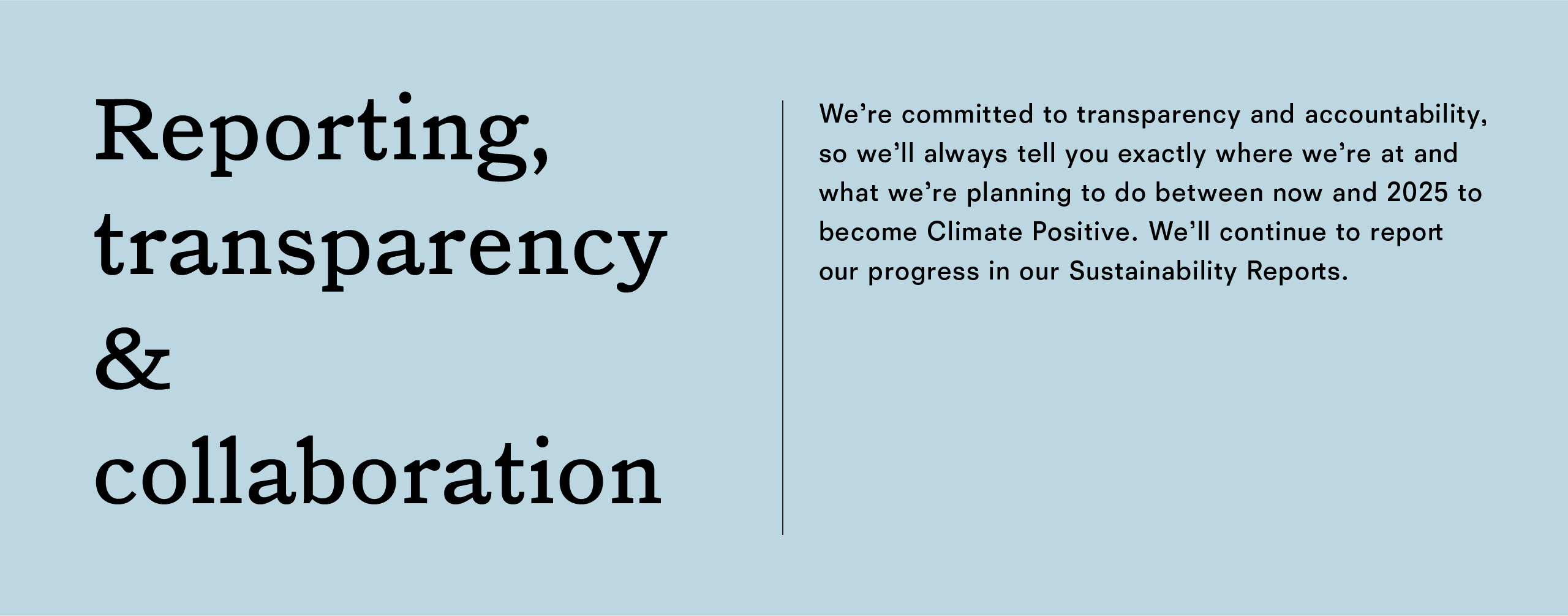
Reporting, transparency & collaboration
We’re committed to transparency and accountability, so we’ll always tell you exactly where we’re at and what we’re planning to do between now and 2025 to become Climate Positive. We’ll continue to report our progress in our Sustainability Reports.
But, at the end of the day, it’s not about what we do on our own, but how we work together. We believe climate change is the most pressing issue facing all people and the planet, and it’ll take all of us to solve it.
We believe in oversharing, which is why we created our How to be a Climate Positive Business guide for any business who’s ready to make a change but may not know where to start. We’re in this together, so if you have any questions, feedback, or other ideas for us, reach out at sustainability@thereformation.com.